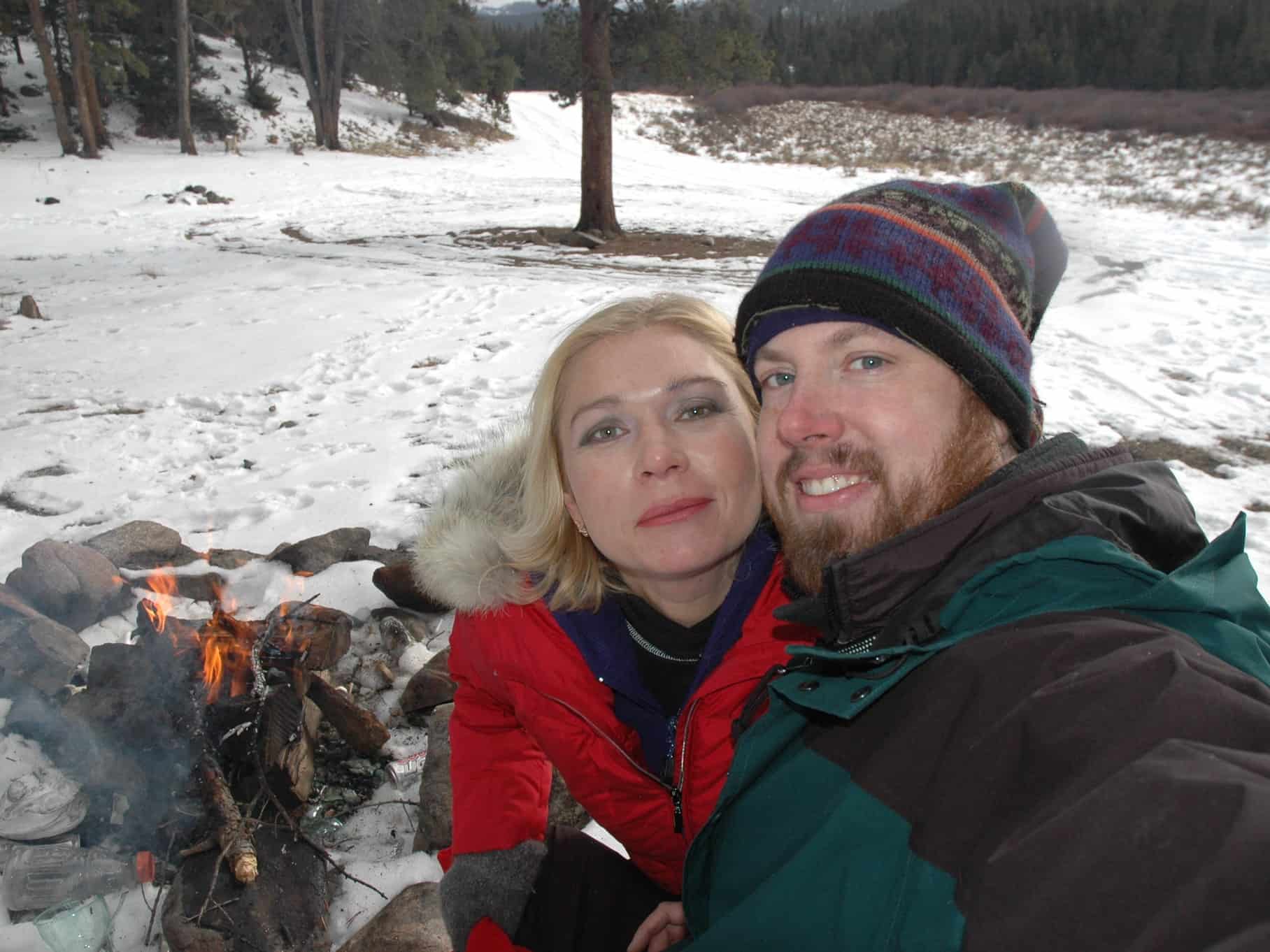Last updated on February 27th, 2023 at 06:11 pm
Staying dry while camping in the cold is not simply a luxury, but an absolute necessity. However, it can be tricky with the lack of sun and warmth for evaporation. Whether it’s sweat soaked clothing from overheating, a wet sock and pant leg from slipping in a creek, or a thicket of wet snow, you’ll need to get dry quick in winter. Because of this, you may be wondering how to dry clothes while cold weather camping.
Here we break down different methods and strategies to dry your clothes efficiently while cold weather camping.
1. Freeze dry
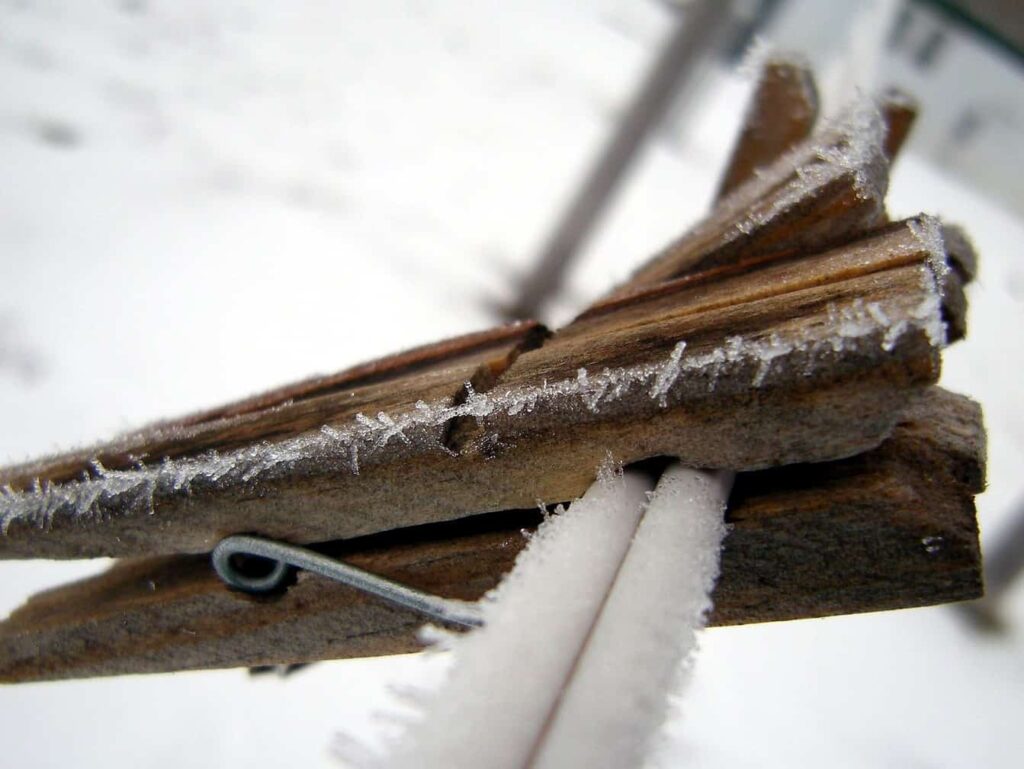
Interestingly, hanging your clothes in the cold might be a great way to dry them. This is because as the water in the material freezes, it hardens. Once it becomes ice, you can shake or beat the ice away.
Additionally, to assist this method further, campers may use a hot water bottle. Heat helps evaporate moisture out of clothes faster. So, to speed up this process, you can add hot water to a Nalgene bottle; then, wrap your clothes around it, or lay them over a couple bottles.
This will help steam dry your clothes white inside your tent without adding a lot of condensation.
2. Portable Heater
Hanging your wet clothes near a portable heater can help water evaporate from the material faster. However, remember not to put clothes too close, otherwise the material may be damaged from the heat.
If you are camping without electricity, there are many portable heaters that run off propane. If you are using these in your tent, make sure it is well-ventilated to avoid chemicals from the propane burn.
Also, be sure to always turn your heater off before you go to sleep, and to never drape clothes on the heater.
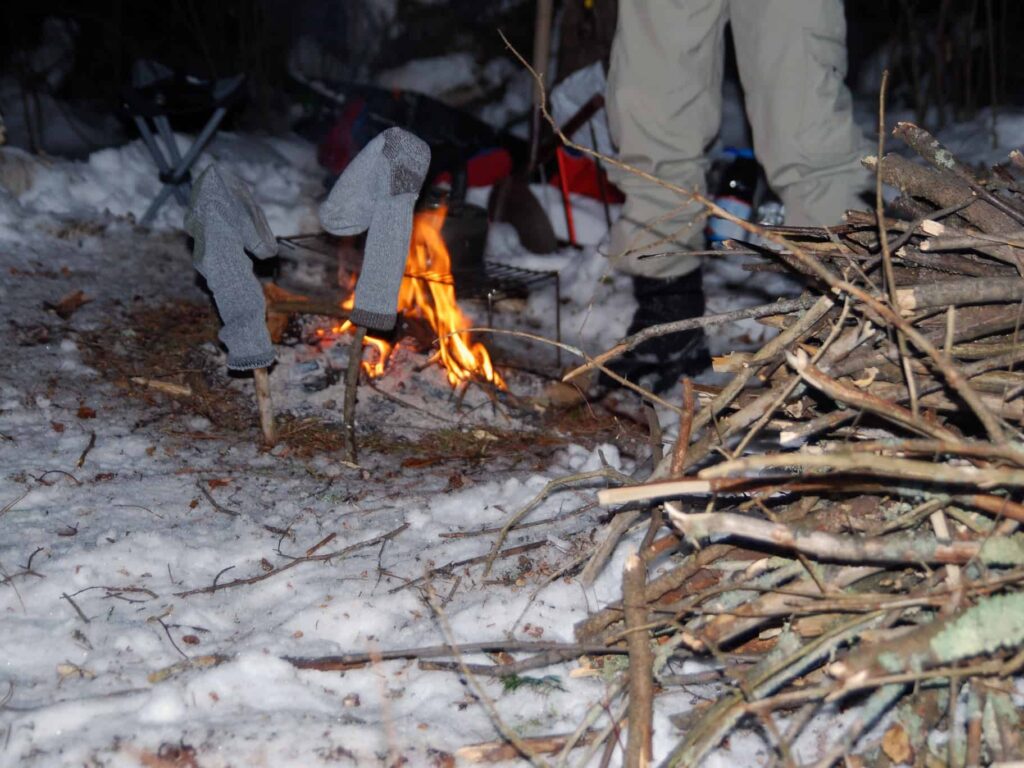
3. Campfire
Obviously, hanging wet clothes near your campfire is a first choice, if you can make one. If you have a clothes line, hang your clothes spaced apart near the fire. The fire should be warm at this distance, but not scorching.
Alternatively, you can hang your clothes on sticks and/or lay them out on rocks near the fire. Both methods will help evaporate the moisture from the fabric.
4. Keep them Covered
Be sure to keep your clothes covered and away from additional overnight moisture, including morning dew. You can bring your wet clothes into your tent with you, and the ambient heat may help dry them more.
One of the drawbacks of this method, however, is that it can create excess moisture in your tent. This, in turn, can make the interior of your tent colder over time.

5. Shammy Method
They might have a weird name, but shammy towels are effective. Make sure to bring a few with you to your camp, since they can wring out moisture.
To use them, simply tightly roll up your wet clothing in them, and press. The towels will help absorb excess water.
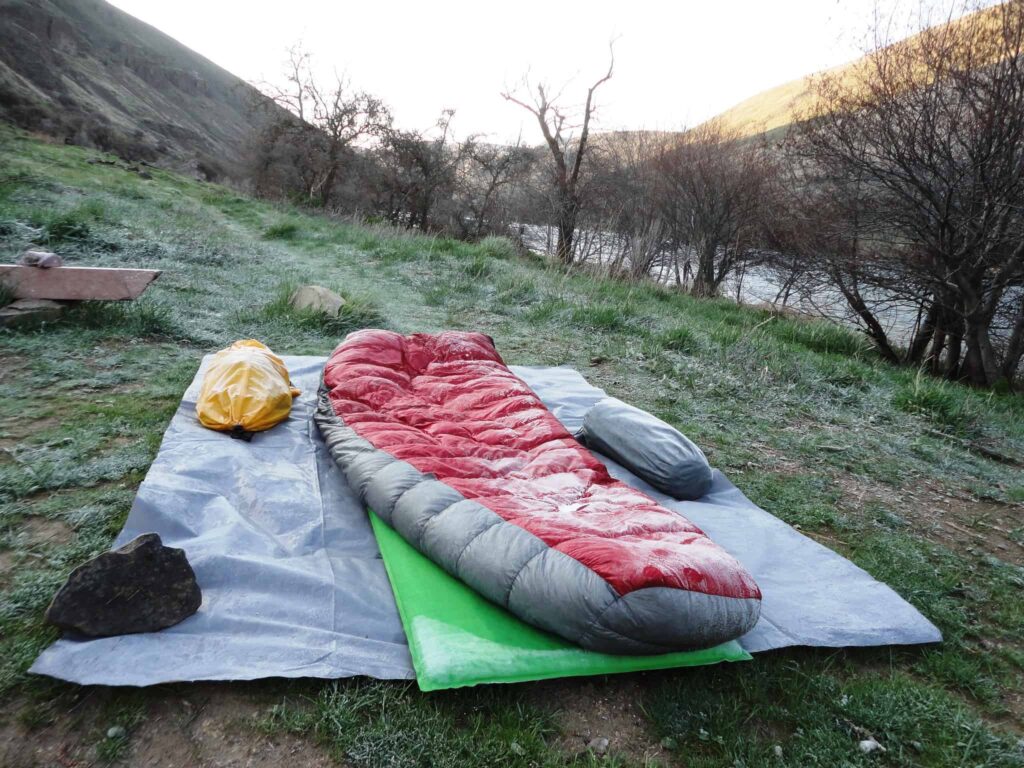
6. Bring clothes into sleeping bag
While this should be considered only as a desperate last resort, try bringing your clothes into your sleeping bag.
The bag liner of your sleeping bag will help wick away moisture, helping them dry faster. You can do this by putting on a dry pair of clothes against your skin, then putting your wet ones on over it. Your body heat and the wicking of the bag will work together to evaporate moisture.
7. Active drying
Another method called active drying uses your body heat to help evaporate moisture from wet clothes.
To do this, you are going to add layers around your wet layer, like this:
- Add a dry base layer against your skin
- Put your wet clothes over this base layer
- Add a shell layer
- Walk around your camp or go for a hike to increase your body temperature
By doing this, your body heat encourages moisture to evaporate to the surface of the clothes, while letting you stay warm.

8. Focus on Preventing Discomfort
While knowing how to dry your clothes is helpful, prevention is often the best route while on camping trips. After all, the more time you spend taking steps to avoid moisture, the more time you’ll get to enjoy the outdoors.
These simple strategies can help keep your clothes dry from the start.
Prevent overheating
It’s easy for many of us to forget that sweating can still be an issue in cold climates. This is especially true if you’re doing vigorous hikes in extremely well-insulated clothing. And, as we know, sweating can moisten clothes.
To help avoid over-sweating, make sure to dress in layers. This will allow you to remove a layer before you start sweating to the point that your clothes get wet.
A good way to practice this is to have a base layer, a middle layer, perhaps one more middle layer, and a shell layer. In this case, you can remove either the shell or the second middle layer.
Wear quick drying clothes
Another strategy to avoid too much moisture is to invest in quick-drying materials. These help wick away moisture faster, rather than absorbing it. Here are a few options:
- Merino wool: Merino wool is a natural fiber produced by Merino sheep. It not only is excellent at wicking away and evaporating moisture, but also helps regulate body temperature. Notice how sheep are never too hot in the summer or cold in the winter? This is due to the wool’s thermo-regulatory effects. We’ve found the best socks in our Best Socks for Hiking in Winter post.
- Polyester or Nylon: These synthetic materials are hydrophobic, meaning they resist water. They also pull moisture away from your skin and evaporate it into the air, rather than hold on to it, like cotton.
You can layer these materials for an extra wicking effect. Merino wool in particular is known for its breathability against the skin.
Wear proper gear
Aside from choosing moisture-wicking clothing, you also want to make sure other pieces of gear can help you avoid wetness. Here are several suggestions:
Wear high boots. Wearing high boots can help protect your ankles and feet from water. If you step in a puddle or shallow stream, a high boot will help keep you dry. Plus, if it rains, the rain will have to penetrate more fabric before soaking your foot. In fact, we’ve found the best boots in our Best Waterproof Hiking Boots for Men and Best Waterproof Hiking Boots for Women posts.
- Tuck pants into boots. Tucking your pants into your boots can help insulate your feet and legs from rainwater and puddles/streams.
- Snow gaiters. Snow gaiters cover the area over your boots and lower pants and are designed to keep wet snow out of your shoes.
- Waterproof shell layer. Adding a waterproof shell layer, such as pants and a jacket, can help repel water. These are especially helpful in rainy, humid climates.
These options will help keep you underlayers dry and protected.
Bring extra clothes
Of course, you should always consider bringing an extra pair of clothes on your trip, even if you have to sacrifice space. This extra pair can be a lifesaver in the event that you can’t get your clothes dry after moisture exposure.
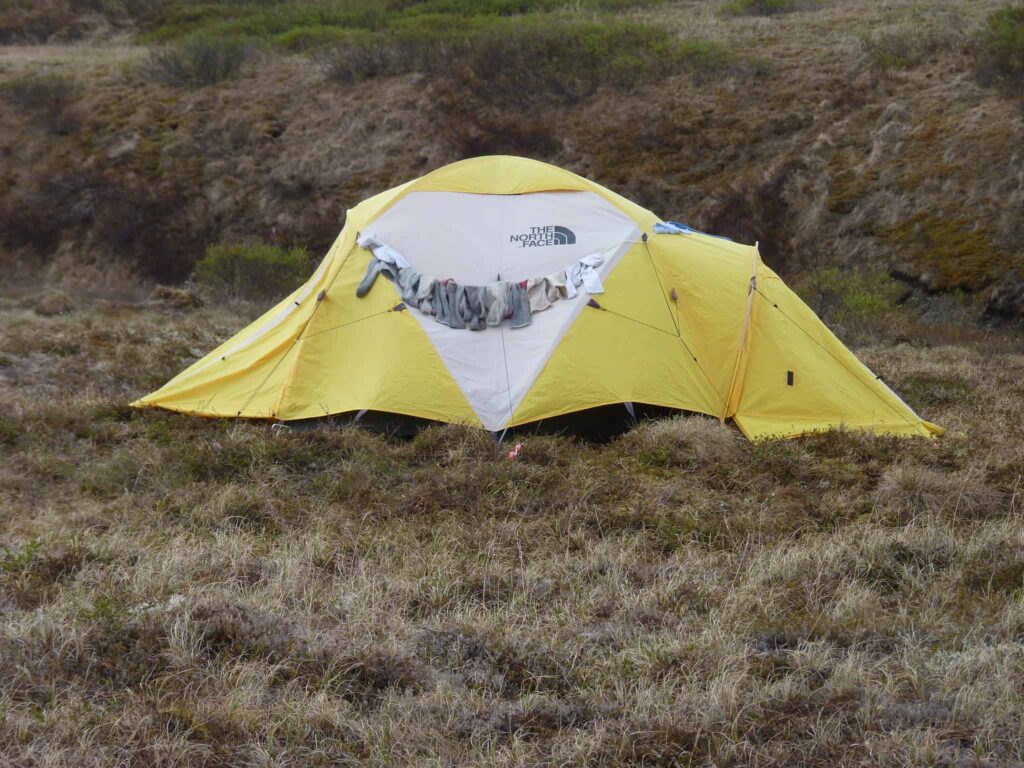
Stay Dry, Stay Safe
Staying warm and dry during cold weather camping is crucial to not only enjoying your trip, but also staying safe. Luckily, there are several methods to help you get your clothes dry, and even prevent them from getting wet. From choosing moisture-wicking clothing to drying by the heater, these methods should help keep you dry.
About the Author
Sarah Sampsell
Title Image Credit, How to Dry Clothes While Cold Weather Camping: Rob Lee | (source) |Attribution-NoDerivs 2.0 Generic (CC BY-ND 2.0) — reduced file size and image
Image Credit 1, How to Dry Clothes While Cold Weather Camping: GollyGforce – Living My Worst Nightmare | (source) |Attribution 2.0 Generic (CC BY 2.0) — reduced file size and image
Image Credit 2, How to Dry Clothes While Cold Weather Camping: Jenny Salita | (source) |Attribution-NoDerivs 2.0 Generic (CC BY-ND 2.0) — reduced file size and image
How to Dry Clothes While Cold Weather Camping, Image Credit 3: Alaska Region U.S. Fish and Wildlife Service | (source) | Public Domain Mark 1.0 — reduced file size and image
How to Dry Clothes While Cold Weather Camping, Image Credit 4: JesseLeeRoper | (source) |CC0 1.0 Universal (CC0 1.0) Public Domain Dedication — reduced file size and image
Image Credit 5, How to Dry Clothes While Cold Weather Camping: Sterling College | (source) |Attribution 2.0 Generic (CC BY 2.0) — reduced file size and image
Image Credit 6, How to Dry Clothes While Cold Weather Camping: Alaska Region U.S. Fish and Wildlife Service | (source) |Public Domain Mark 1.0 — reduced file size and image

